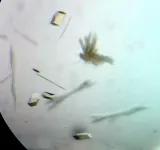How ethane-consuming archaea pick up their favorite dish
Scientists of Bremen sucessfully decoded the structure of the enzyme responsible for ethane fixation
2021-07-02
(Press-News.org) This insight is the result of the close collaboration of several research groups at the Max Planck Institute for Marine Microbiology. A team around Cedric Hahn and Gunter Wegener recently discovered ethane-degrading microbes at hydrothermal vents of the Guaymas Basin at a water depth of 2,000 meters in the Gulf of California. They named it Ethanoperedens thermophilum, which means "heat-loving ethane-eater". Cedric Hahn a PhD student from the research group Molecular Ecology cultured the ethane-degrading microbes in the laboratory. Hahn, Wegener and colleagues of the research group Microbial Metabolism, Tristan Wagner and Olivier Lemaire took a closer look at these microorganisms. This collaborative work unraveled the secrets behind the ethane fixation. "We were astonished by what we found. Besides a global similarity, some features of the enzyme differ fundamentally from its counterpart - the enzyme responsible for the degradation of methane," says Gunter Wegener, scientist in the Research Group for Deep-Sea Ecology and Technology.
Ethane-eaters depend on the same enzyme as Methane-eaters
In deep-sea sediments, geothermal heat leads to the degradation of organic matter to oil and natural gases such as ethane. The ethane is consumed by different microorganisms that form a so-called consortium: archaea, which break down the natural gas, and bacteria, which couple the electrons released in the process to the reduction of sulfate, an abundant compound in the ocean. The discovery of the ethane-eating microbes has brought a breath of fresh air to the research. Compared to microbes eating methane that take a lot of time to grow, the ethane specialists grow much faster and double every week. Thus, the time of biomass production is reduced, which allow attempts of purification and characterization of key enzymes catalyzing the oxidation of natural gas.
To test similarities between the enzymes catalyzing the activation of ethane and methane, Cedric Hahn added a well-known molecular inhibitor of methane oxidation to his culture. This treatment abolished also ethane oxidation. "This suggested that the ethane-oxidizing archaea activate ethane in similar enzymatic reactions as those acting in methane degradation/generation" says Cedric Hahn. Such enzymes are a key expertise of Tristan Wagner who studied them for several years.
A structure visualized at an astonishing level of precision
Cedric Hahn and Olivier Lemaire, the two first authors of the paper now published in Science, then tried to purify the enzyme responsible for ethane fixation. "The project was highly challenging," says Olivier Lemaire. "Usually we purify the enzymes from much larger amounts of biomass from a culture containing one microorganism. However, we finally yielded sufficient amounts of pure enzymes for structural analyses."
The next critical step was to obtain crystals of the enzyme to determine its tri-dimensional structure. "X-ray crystallography gave previous excellent results on this group of enzymes" says Tristan Wagner, head of the Microbial Metabolism research group and expert on this technique. "We analyzed these crystals by X-ray diffraction and solved the enzyme structure at an unprecedented atomic resolution. We can thus determine the position of individual atoms and obtain therefore an extremely precise picture of the structure".
The structure exhibits several unprecedented features. "We noticed that the catalytic chamber in which the chemical reaction takes place is twice as large as in enzymes capturing methane, which makes sense considering that ethane is bigger than methane," says Olivier Lemaire. The cofactor, catalyst of the reaction, contains two additional methyl groups. These methyl groups were confirmed by Jörg Kahnt from the Max Planck Institute for Terrestrial Microbiology, a worldwide expert on this cofactor. "We found a protein that could be responsible for these methylations, and it is only found in ethane-consumers," says Cedric Hahn. Since the chamber is more voluminous, a normal cofactor would simply not fit properly and would impair the reaction. The methylations on the cofactor anchor it in the correct position.
Furthermore, the enzyme contains a tunnel connecting the exterior to the catalytic chamber. This tunnel does not exist in any characterized similar enzymes. The researchers experimentally proved the existence of this tunnel through a collaboration with Sylvain Engilberge at the Paul Scherrer Institute in Switzerland, where the protein crystals were gassed with xenon. Xenon was detected in the catalytic chamber and the predicted gas tunnel, proving its existence. The tunnel is maintained and stabilized by modified amino acids and additional extensions.
Now the spotlight turns to propane and butane
The enzyme structure illustrates how these microbes from geothermally active seeps became specialized in ethane capture. This work allows a deeper understanding of the first step in ethane degradation, the only source of energy of these archaea. "Our finding that the enzyme responsible for the process has specific traits to recognize ethane rather than other alkanes is a big step forward, however the understanding of the whole degradation process is still a long way off", concludes Tristan Wagner.
So, how to proceed the research? "Our previous works show that the activation of longer alkanes requires similar enzymes" says Gunter Wegener. "As a next step, we want to investigate what could be the specific features of the enzymes that catalyze the activation of propane and butane".
INFORMATION:
[Attachments] See images for this press release:

ELSE PRESS RELEASES FROM THIS DATE:
2021-07-02
"We have studied which temperatures are preferable and which are harmful in humans, cattle, pigs, poultry, and agricultural crops and found that they are surprisingly similar," says Senthold Asseng, Professor of Digital Agriculture at TUM. According to the study, preferable temperatures range from 17 to 24 degrees Celsius.
When does it become too hot for humans?
At high humidity, mild heat strain for humans begins at about 23 degrees Celsius and at low humidity at 27 degrees Celsius. "If people are exposed to temperatures above 32 degrees Celsius at extremely high humidity or above 45 degrees Celsius at extremely low humidity for a lengthy period of time, it can be fatal," says Prof. Asseng. "During extreme heat events with temperatures far above 40 degrees Celsius, such as those ...
2021-07-02
Plastics are a growing problem for natural ecosystems around the globe, and in particular for our marine and freshwater environments. Rivers are the leading source of plastic pollution, as it has been estimated that they deliver several million metric tons of plastic annually to our oceans from poor land-based waste management. The problem is that the estimates made for plastics flowing from the rivers are tens to hundreds of times higher than the quantity of plastics floating on the ocean's surface. So where is all of this river-derived plastic actually going - is there a missing plastic 'sink' somewhere in the ocean? Are the estimates correct?
In a paper published ...
2021-07-02
Originally discovered as a bacterial mode of defense against invading viruses, the remarkable ability of CRISPR-Cas9 to modify specific locations of DNA has made it a researcher favorite among gene editing tools. The ongoing effort to explore further possibilities of the CRISPR-Cas9 system is ushering in newer developments to this tool. In one of the latest refinements of the technique, as illustrated in a study published in BioDesign Research, scientists from Stanford University, USA have developed a CRISPR-Cas9 system that induces highly effective silencing of target genes.
The versatility of CRISPR-Cas9 based gene editing is largely ...
2021-07-02
New research published in The Journal of Physiology shows that researchers have successfully repurposed two existing medications to reduce the severity of sleep apnoea in people by at least 30 per cent.
Affecting around 1.5 million adults in the UK, sleep apnoea is a condition where the upper airway from the back of the nose to the throat closes repetitively during sleep, restricting oxygen intake and causing people to wake as often as 100 times or more per hour (1).
Those with untreated sleep apnoea are more likely to develop cardiovascular disease, dementia and depression, ...
2021-07-02
NDIANAPOLIS--Indiana University School of Medicine researchers are developing a new, noninvasive brain stimulation technique to treat neurological disorders, including pain, traumatic brain injury (TBI), epilepsy, Parkinson's disease, Alzheimer's disease and more.
"Given the increasing use of brain stimulation in human brain study and treatment of neurological diseases, this research can make a big impact on physicians and their patients," said Xiaoming Jin, PhD, associate professor of anatomy, cell biology and physiology.
When someone experiences a brain injury, nerve injury, or neurodegeneration, such as in epilepsy and TBI, there is damage to the brain which can lead to loss ...
2021-07-02
Small children learn language at a pace far faster than teenagers or adults. One explanation for this learning advantage comes not from differences between children and adults, but from the differences in the way that people talk to children and adults.
For the first time, a team of researchers developed a method to experimentally evaluate how parents use what they know about their children's language when they talk to them. They found that parents have extremely precise models of their children's language knowledge, and use these models to tune the language they use when speaking to them. The results are available in an advance online publication ...
2021-07-02
Lugano, Switzerland, 2 July 2021 - Obese patients with colorectal cancer receive lower cumulative doses of adjuvant chemotherapy, relative to their body surface area (BSA), than non-obese patients, show results from a large meta-analysis reported at the ESMO World Congress on Gastrointestinal Cancer 2021 (1). Further findings showed that cumulative relative chemotherapy dose was associated with survival so may explain the poorer survival that has been seen in obese patients receiving adjuvant chemotherapy for colorectal cancer. (2)
"Adjuvant chemotherapy ...
2021-07-02
Lugano, Switzerland, 2 July 2021 - Doctors and patients are being advised to reduce unnecessary antibiotic use following new data suggesting that these medicines may increase the risk of cancer of the large intestine (colon), especially in people under 50 years. (1) The results, presented at the ESMO World Congress on Gastrointestinal Cancer (30 June-3 July) raise fresh concerns about the impact of the estimated 65% increase in global antibiotic consumption reported between 2000 and 2015, despite not showing a direct cause and effect. (2)
"To our knowledge, ...
2021-07-02
Plastic is notoriously hard to break down, but researchers in Austria have found that bacteria from a cow's rumen - one of the four compartments of its stomach - can digest certain types of the ubiquitous material, representing a sustainable way to reduce plastic litter.
The scientists suspected such bacteria might be useful since cow diets already contain natural plant polyesters. "A huge microbial community lives in the rumen reticulum and is responsible for the digestion of food in the animals," said Dr Doris Ribitsch, of the University of Natural Resources and Life Sciences in Vienna, "so we suspected that some biological activities could also be used for polyester hydrolysis," a type of chemical reaction ...
2021-07-02
Oncotarget published "Loss of CPAP causes sustained EGFR signaling and epithelial-mesenchymal transition in oral cancer" which reported that not only do the abnormal functions of microtubule and microtubule-organizing centers such as centrosomes lead to cancers, but also the malignant tissues are characterized by aberrant centriolar features and amplified centrosomes.
In this study, the authors show that the loss of expression of a microtubule/tubulin binding protein, centrosomal protein 4.1-associated protein, which is critical for centriole biogenesis and normal functioning of the centrosome, caused an increase in the EGFR levels and its signaling and, enhanced the EMT features and invasiveness of OSCC cells.
Further, depletion of CPAP ...
LAST 30 PRESS RELEASES:
[Press-News.org] How ethane-consuming archaea pick up their favorite dish
Scientists of Bremen sucessfully decoded the structure of the enzyme responsible for ethane fixation



